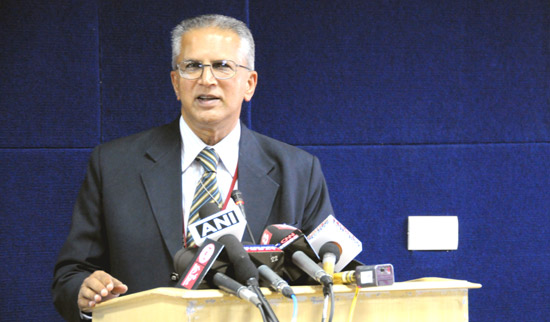
- This event has passed.
Eminent Persons’ Lecture Series – Left-Wing Extremism in India
March 5, 2010
Venue: Seminar Hall 1, IDSA
Speaker: Mr. Gopal K. Pillai, Home Secretary, Ministry of Home Affairs, Government of India

On March 5, 2010, as part of its Eminent Persons’ Lecture Series, IDSA organized a lecture by Home Secretary Gopal K. Pillai on “Left Wing Extremism in India”. Pillai shared with the distinguished audience his own perspective on the Naxal movement, which is considered to be one of the most serious internal security threats faced by India today.
The origins of the Naxal movement can be traced back to the 1960s when Naxalites started operating from various parts of the country. However, Naxalism emerged as a real security threat when armed groups like the Peoples’ War Group and the Maoist Communist Centre joined hands in 2004 and formed the Communist Party of India (Maoists) — CPI (M) — to fight against the Indian state. In fact, one of the basic objectives of the Naxal movement, as identified by Pillai during the course of the lecture, is the overthrow of the state in India. Naxals do not believe in parliamentary democracy and in fact consider parliament a pigsty. While projecting the state as well as its armed forces as the ‘enemy’, the Naxal movement calls upon its members to take up arms and defeat the enemy decisively. The movement believes that the state is merely an agent of the elitist class and does not really cater to the interests of the lower stratas of society.
While discussing the methodology of the CPI-Maoists, Pillai argued that the members of the Naxal movement initially try to infiltrate and develop their bases in underdeveloped areas where there exist some sort of an administrative vacuum. Once these bases become strong enough, the Naxalites start expanding their influence in the surrounding areas as well. While taking advantage of the feeling of neglect among the people, the Naxalites start educating them about their exploitation by the Indian state and how to bring an end to such exploitation through an armed struggle.
According to Pillai, many youths get inspired by the radical ideas advocated by the Naxal movement and try to achieve these goals. However, once they realize that the movement is not as ideal as they had initially expected, they try to come out of it.
Pillai also stated that the violence profile of extremism in India is going up every year. In fact the year 2009 was the bloodiest of all. He warns that the coming years will see more and more violence. This is so because the Indian state has decided not to give in to extremists’ demands and instead tackle them head on.
During his lecture, Pillai asserted that the armed cadres and weapons of the Naxalites have been slowly built up by the CPI-Maoists. Such cadres have three basic modules. Among these, the real armed cadre is the back bone of Naxal armed forces. At the same time, it is also the most sophisticated one. However, this cadre base is still used as a reserve cadre. Unfortunately, the Indian government has not been able to catch hold of even five per cent of the real armed cadres of the Naxalite movement. While emphasizing that all the three cadres of the movement are highly modernized and well trained, Pillai stated that the CPI-Maoists carry out excellent post mortem of their operations with military like precision, which helps them improve their future armed operations.
According to Pillai, since the Naxal movement does not believe in peaceful discussion and emphasizes on armed struggle, the Indian government has not been able to bring about much results through dialogue. However, he hopes that the Naxalites will feel the pressure within one or two years once the Indian government starts putting its act together. The desired results have not been achieved so far particularly because the police force, which should have been in the forefront of the fight against Naxalism, has been highly neglected and it is particularly ineffective in the Naxal affected areas.
Pillai also threw light on certain aspects of police reforms in India. According to him, although a huge amount has been allocated by the Finance Commission recently for the purpose of police training, the police force is still in a pretty bad shape. In many areas, the actual number of police personnel is much lower than the posts sanctioned. Thus, a huge number of police posts lie vacant. According to Pillai, at a time when unemployment is still a big issue in India, many youths can take up the police profession. He also mentioned that if enough youths from Naxal affected areas can be recruited into the police, law and order can be improved in those areas to some extent.
Pillai also stated that in recent years the intelligence gathering system in Naxal affected areas has improved and that is why the government has been able to catch hold of a few CPI-Maoists politburo members in the last few months.
While explaining the reasons behind the origin of the Naxal movement in India, Pillai talked about the loopholes in the Indian forest conservation act, the mining act, land acquisition law, power plant law, etc. He personally believes that until and unless necessary measures are adopted by the government in reforming these acts, it will not be possible to uproot the Naxal movement or any other extremist movement from India.
While concluding his speech, Pillai offered the audience a hopeful picture by stating that with the police reforms being undertaken at present, the Indian government will be able to take control of the civil administration within 7 to 10 years and minimize the influence of the Naxal movement to a large extent.
This report has been prepared by Pranamita Baruah, Research Assistant, IDSA.







